You can’t always tell a book (or in this case a 1937 Packard) by its cover. Who would’ve thought that underneath that original 85-year-old paint and interior and overall stock appearance lies a small block V8, automatic transmission, and power steering? (The seller has the original engine if the next owner wants to rebuild it and put it back together.) Located in Brush Prairie, Washington (great name!), this rare 1937 Packard Super Eight Sedan is for sale here on eBay. As of this writing, 17 bids had been submitted, but the $14,234 highest bid hadn’t met the seller’s reserve.
This car just oozes classic 30’s-era Packard prestige with its flowing fender lines and streamlined styling that still looks good today from every angle. The seller shares that the Packard was purchased from a collection of over 300 cars in an estate sale in Idaho. When purchased, its original Inline 8 engine wasn’t running. The seller worked on it but says “after resealing, the engine ran but was getting water into seven and eight cylinders due to a small crack.” It was then that the seller decided to “modernize” the old Packard.
The black paint is original and still looks good and shines for its age. It’s not perfect and the seller includes photos of scratches and admits it has cracks and rock chips. In the ad, the Packard is described as “a very solid car with good floors and no rust; it might have some surface rust but nothing major.” It looks very straight and solid and all there. It’s impressive and has obviously been garaged and taken care of for the past 85 years.
Although the seller describes the original interior as “in OK shape, not perfect, there are some rips, and the carpet is old,” I think it looks amazing overall for its age as the photos attest. The dash is absolutely beautiful and the tasteful gray wool broadcloth interior is well-above presentable. This was elegance and luxury at its finest in a motor car 1937.
The seller doesn’t provide details about the mechanical “surgery” performed other than it currently has a small block V8, an automatic turbo transmission, and aftermarket power steering that is described as working great. Overall, the seller states that the Packard “runs and drives really nice and shifts through every gear. The brakes are really good and I would not hesitate driving the car for hours.” The only thing listed as needing are new tires, the current set is described as old and cracking. So, what do you think? This is a very rare Packard as only 5,793 total Super Eight 2-door coupes, 2-door convertibles, and 4-door sedans were built in 1937. I’m sure some purists are coordinating a collective gasp and shouting, “Heresy!,” but I’m cool with the idea of adding modern mechanicals under the skin of a classic ’37 Packard.
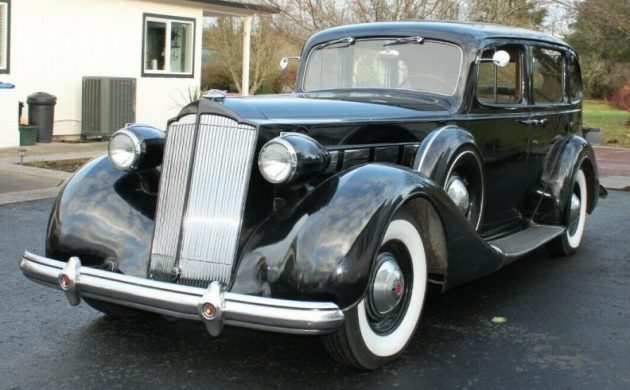
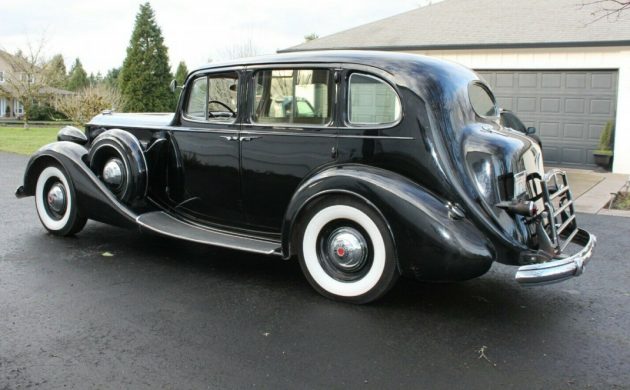
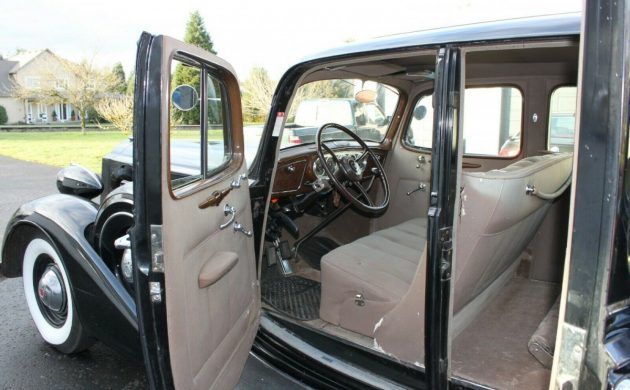
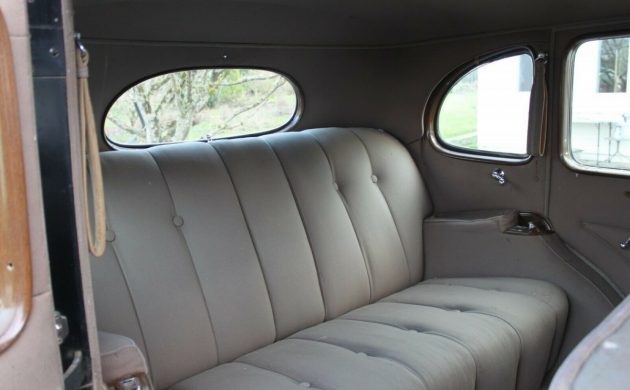
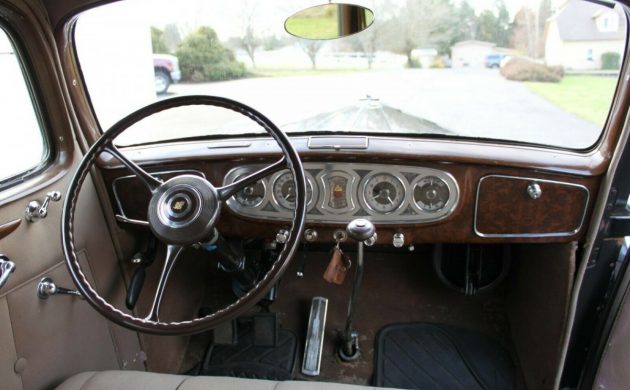

What a shame.
Travesty.
Well, I’ll tell ya’, I know what I hate,,and I don’t hate this. It’s actually a resto mod that every full classic could hope for in this day and age. There was nothing wrong with the stock setup,,,for 1937, and could still be usable, except, this takes it to a another level, a better level for today. Driving full classics, in their original form, is,,shall we say, challenging. Not sure what it is, 327? Sharp SBC fans will know, but some cool touches, like the valve covers, the automatic, not a fire breather, probably lighter than the straight 8, runs cooler, much better power, as dependable as that Chevy Impala, yet riding in a stately Packard. Sounds pretty cool to me. Someone did a nice job here.
Sharp SBC fans will tell you they all look the same on the outside. You can tell the range of some years, which would give you a clue as to what was available that year. There is no picture of the area on the front of the block where the stamped number is. You can always tell by the bore and stroke, knowing that the overbore if any would be stamped on the top of the pistons. Who wants to take it apart?
Heads and intakes get swapped around like the latest styles in wheels and tires.
Memories, my first driving experience in a ’38 with the straight eight. Good ride through the New England hillsides. My brother bought it when he got out of the Navy at the end of the war. It was a funeral directors car and only had 5000 miles on it. Classy.
As always, Howard provides true words. If this was in my neighborhood and I saw it was for sale, I believe I would guaranteeing whatever my wife wanted for the rest of our lives. The new mechanics just about make it perfect for an every day driver in this pandemic workplace. I only need about 50 miles a week. That front seat looks so comfortable, I would be smiling every minute of the drive. Would be curious what the reasonable cruising speed would be (even with a speedometer going to 120, I doubt 70 is reasonable). I honestly could drive this the next 20 years as long as no one TBoned me.
I was all ready to rag on Ron, because he didn’t say what kind of small block was in the car, but after looking at the e-Bay ad, the seller didn’t specify, and maybe Ron doesn’t know how to tell a Ford from a ChryCo from a Chebbie. I’d bet it’s a crappy 305 or 307, though Howard may be close, since the ram’s horn exhaust manifolds would make you think it’s a 327.
Well, it comes with the original engine, so, I don’t see the problem plugging in a substitute, if you plan on having a really clean, fancy, head turning daily driver while resurrecting the original lump.
The only pictures here show a stick and 3 pedals? No engine picture!
In my mind there’s nothing wrong with this engine swap. It makes the car drivable the frame and the body have not been hacked up. For the puristic it can be reverted back to stock this makes it a dependable driving machine. It’s when one starts cutting up the infrastructure that creates a travesty Just my humble opinion
The arguments for the V8/auto-trans conversion are practical. I won’t deny that. BUT some folks just simply won’t grasp the idea that the experience of a prewar collectible car – particularly a luxury model – is much more than visual. It’s also audible, and it is tactile.
I really applaud the owner for having maintained the interior, as well as exterior, in such beautiful original condition. That opulance is there for all to see and enjoy. But what a disappointment to hit the starter and hear these totally foreign sounds. “Surely, this is NOT a Packard,” you say to yourself. “Help, I’m caught up in a netherworld nightmare!” you hear yourself screeming. You look under the hood and absolutely nothing even looks familiar. “What is going on? Where am I?”
Reluctantly, you agree to drive the car. Where is that big, heavy, rectangular Packard clutch pedal? You reach for the shift lever, expecting that slight grind as you bring it over and down to “low”. If it grinds too much, you take it up toward “intermediate”, gently bumping the synchronizers just enough to ease the car quietly into “low”. And now you await the feeling of the initial bite of the clutch. And on it goes… But in this elegant rabbit hole, all is strange yet all is too familiar. And after spending all the money and engaging in the endless search such an original looking car, you ask “Why am I being deprived of the actual experience of DRIVING a ’37 Packard?”
That’s right: “deprived!” This car is not “the REAL THING”.
Now, if you run across a sadly decrepit, dented, rusty, prewar Packard and choose to rescue it just inches away from the crusher – thinking what a splendid street rod you could build from it, be my guest – my WELCOME guest! Build it with 450 hp, totally modern suspension and braking, all the performance, comfort, and conveniences of a superb modern street rod. And subtley make it LOOK like one – finished off with a dark metalic paint-job that changes color depending on how you look at it, and stunning alloy wheels of course. Interior: suit yourself as long as everything breathes of elegant taste and QUALITY! I’ll be the first to admire it.
But on this particular car… Are the original engine and transmission mounts still there?
Allen, I think the old saying rings true, i didn’t build my car to suit you, I built it to suit me. If you want a car to suit you, feel free to build it.
Hi Wayne,
‘ Sorry – ‘ guess I really put my foot in it! But, it seems I am free to turn your argument around: I didn’t write my comments to suit you; I wrote them to suit myself. That sounds more argumentative than intended, but I’m not sure how else to say it. While I can’t unshoot my cannon, I can lament that my reaction was not a very fair representation of my own normal eclectic tolerence for the “roads [I have] not taken”.
If you have all the bits and pieces to reverse your modifications, I retract my objections. I have no basis on which to question what you do with your own car. I might even enjoy it. But if the car is a sufficiently rare and significant cultural artifact, I can wish you had not modified it, citing an unwritten but generally recognized obligation to preserve such artifacts for posterity. Sometimes, ownership carries with it a custodial obligation. In that spirit, I whole-heartedly endorse your choice to preserve all the visual details of this car! I just wish you had addressed the mechanical aspects with the same reverence. But that’s just me…
Great post,,couple things, I believe Packard was the 1st to feature all synchro transmissions, so no “1st gear grind”, but I appreciate what you say. You say someone will be “deprived” of a “real” Packard,,that’s true, to folks like you and I, however, we must remember, we’re a dying breed, and most people have never heard of a Packard car, and wouldn’t know the difference what was under the hood, especially by sound alone. I think a setup like this brings it full circle and offers the best of both worlds.
PS: There is indeed an engine picture. Perhaps added after your post, Pete?
Nice touch: the “Packard” marking on the valve covers. Could this be a post-war mid-50s Packard V8? That would soften the blow a little bit anyway…
Ruined that book!!
Don’t be so harsh on the seller. I think he did a beautiful job in trying to keep this Packard as original as possible. If I had the funds to purchase it, I would be proud to be seen driving it along the NH Seacoast!!
The flathead eight is an easy, cheap rebuild and hardly more expensive than the motor swap. You gain nothing and it is the lazy man’s way out.
A shame.
I like it, but probably would have put a Buick nailhead in it. Price as I write is just over $15k reserve not met. That doesn’t surprise me, if it was mine I wouldn’t take less than $30k for it.
God bless America
I’m a Packard Fan & club member, and I am a Restomod fan. I like this. I wonder if it was converted to 12V. I’d add A/C, and drive it any day of the year. I’ve read the conversations about the pains & costs of getting a Packard 8 rebuilt on the forums, and the plague has not improved things. Cracks in the block did it say also? If I had the place to park this and it was about 6 states closer… I would be apologizing to the wife in a few days. LOL
Howard A –
As my dad used to say: “OK, you win. Pick up the marbles.” I’m afraid I’m simply revealing my age here. When I was a kid in the late 40s and early 50s, I could identify most common makes of American cars by the sounds they made. My dad could not even visually distinguish them, claiming they all looked alike. When I got to his age, I couldn’t either – for the same reason. In fact, he would lament how distinctive the cars of the 20s± were. They all looked alike to me! I finally learned to distinguish a Model A Ford from a Chevy or a Dodge. They still looked alike to me, but I learned to take note of the Ford’s distinctive radiator shell.
Budding car nuts notice this stuff about the cars of their youth. Perhaps today’s kids can hear the difference between a Toyota and a Honda. I sure can’t. I can no longer distinguish the sounds of a four vs a V6, vs a V8 anymore – unless the four is an MGB…
So, my argument probably applies only to myself – and perhaps a handful of other ancient car fossils.
A disgrace if the exterior or the cabin had been changed, but it hasn’t.
Now we have a car that can be driven and seen by people who otherwise may never see one on the road.
OK it won’t feel the same to drive, and as someone who has owner 1930s cars I do know what you mean, but if you don’t like that then don’t drive it.
Hats off to the builder.
The original engine might be rescued with a can of K Seal, or it might not. Cracked block, hmmm.
Anyway, I approve of this car.
just what my plan was at 14y.o. for my Barnfind $200 1937 Pacard 120CD — My Dad told me to get my license and drive it for a year 1st –Found out original straight eight was fine for a high school student commute – Datenights and summer fun.
40 years later –original engine was much better $$$ sale.